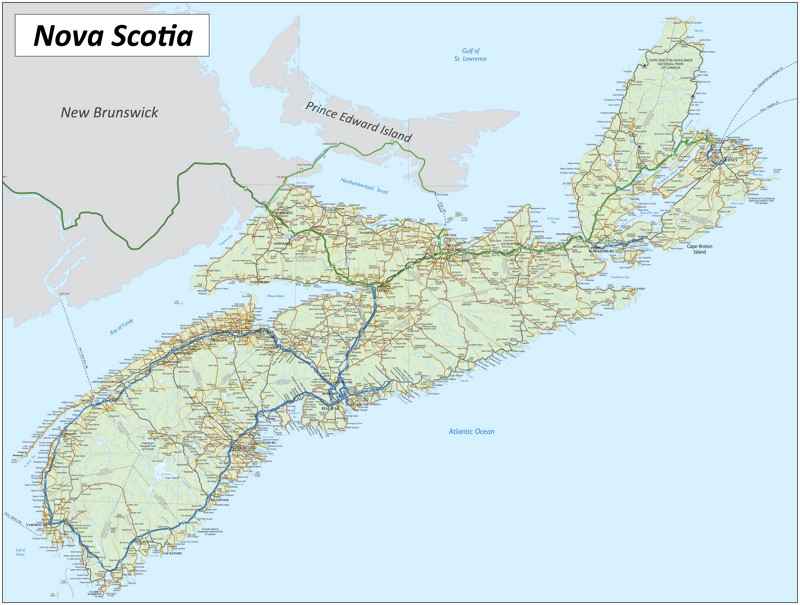Detailed Map of Nova Scotia
Description:
This map shows cities, towns, villages, counties, rivers, lakes, highways, major roads, secondary roads, and ferries in Nova Scotia.
Size: 5885x4450px / 4.87 Mb
Nova Scotia is a maritime province located on the eastern coast of Canada. Covering an area of 55,284 square kilometers, it consists of the Nova Scotia peninsula, Cape Breton Island, and approximately 3,800 smaller islands. The province is connected to the mainland of Canada by a narrow isthmus with New Brunswick and is surrounded by the Atlantic Ocean, making it the most populous Atlantic province in Canada.
The geography of Nova Scotia is characterized by diverse landscapes. The terrain is mostly hilly with numerous lakes - over 3,000 in total - with Bras d'Or on Cape Breton Island being the largest. The coastline stretches an impressive 10,427 kilometers, featuring many natural harbors. The highest point is White Hill at 532 meters, located on Cape Breton Island. The climate is continental with significant maritime influence, resulting in relatively mild winters and cool summers compared to inland regions of Canada.
Historical significance runs deep in Nova Scotia, which is considered the cradle of both Acadia and Canada. The first European settlement north of Florida was established by the French in 1605 at Port Royal. The province was originally called Acadia by French settlers before being renamed Nova Scotia ("New Scotland" in Latin) in the 1620s. It became a battleground between British and French forces until the 1713 Treaty of Utrecht, when mainland Nova Scotia was ceded to Britain. In 1755, British authorities expelled thousands of French-speaking Acadians. Nova Scotia was one of the founding provinces of the Canadian Confederation in 1867.
The economy of Nova Scotia is diverse and historically centered around maritime industries. Fishing remains significant, with the province being a major exporter of lobsters and other seafood products, generating over $1 billion in exports annually. Other key sectors include mining (coal, gypsum, salt), forestry, agriculture (particularly in the Annapolis Valley region), tourism, healthcare, information technology, and education. The discovery of offshore oil and natural gas reserves has become an important economic driver since the 1990s.
Halifax, the provincial capital, serves as the economic and cultural hub of Atlantic Canada and hosts the largest port on Canada's Atlantic coast. The city is home to several universities, including Dalhousie University, and maintains significant military facilities. With its rich heritage, stunning coastal scenery, and vibrant cultural scene, Nova Scotia continues to attract tourists and immigrants seeking its high quality of life and work-life balance.
Maps of Nova Scotia: Tourist Map of Nova Scotia | Nova Scotia Road Map | Nova Scotia Highway Map | Nova Scotia National Parks Map | Map of Cape Breton Island
You may download, print or use the above map for educational, personal and non-commercial purposes. Attribution is required. For any website, blog, scientific research or e-book, you must place a hyperlink (to this page) with an attribution next to the image used.
Maps of Canada
Provinces and Territories
Cities of Canada
Cities of Canada

